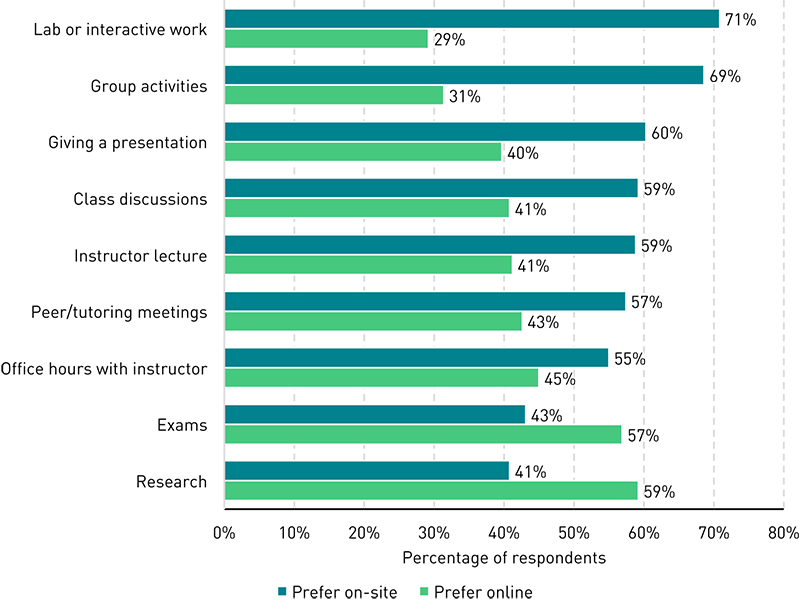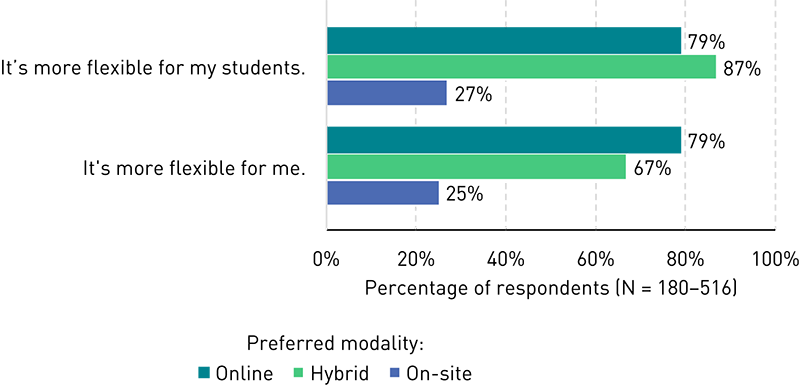Changes in Student and Faculty Learning Modality Preferences
Findings from the two recent EDUCAUSE technology reports on students and faculty show that while on-site teaching remains a preferred modality for many students and faculty, online and hybrid modalities make up a significant percentage of personal preferences. An increasing preference for online or hybrid courses should come as no surprise as we continue to feel the effects of the global pandemic and the emergency shift to online learning that students and faculty had to go through. The improvements to synchronous and asynchronous content delivery technology have made online and hybrid courses a much more comfortable choice for many. This context is important for institutions as they consider how to support students and faculty with technology and training in creating courses in their preferred modality.
A Note on Modality Terminology & Practice
At EDUCAUSE, we recognize that higher education stakeholders have not come to a consensus on the way instructional modalities are labeled and operationalized. People have different definitions and understandings of courses that are labeled as "online," "online synchronous," "online asynchronous," "hybrid," "blended," "HyFlex," and "in-person." While it was beyond the scope of this study to perform a deep dive into the nuances of modalities, we felt it was important to assess the extent to which instructional modalities included remote or on-site and synchronous or asynchronous components, and whether technology was used to support teaching and learning. Thus, we used the Revised Modes of Learning Spectrum to ask about modality preferences and teaching experiences across modalities. This framework is based on research showing that most teaching and learning experiences fall into three broad categories of modalities: online, hybrid, and in-person technology-supported learning. Throughout this report, we use the term "on-site" to describe courses that take place on-campus (aka, in-person or face-to-face) and "online" to describe courses held remotely from a space outside of the classroom.
On-site teaching remains the modality preferred by most students and faculty. When looking at the results from both reports, 53% of students and faculty indicated a preference for learning and teaching on-site (see figure 1). By comparison, in 2019 73% of faculty and 70% of students preferred courses to be taught mostly or completely on-site, while only 6% of students and 9% of faculty preferred completely online courses.

For the students, their preferences differ depending on the type of activity they're engaging in, with on-site preferences particularly strong for activities such as labs or interactive work (71% on-site) and group activities (69% on-site). The only two activities not preferred as on-site by a majority of students were of a more typically "individual" type, not necessarily dependent on direct interactions: exams (43%) and research (41%) (see figure 2).

Despite this shift in modality preferences, the overall pattern remains similar to pre-pandemic findings—the most preferred mode of courses is still on-site, but institutions need to keep track of these shifts to ensure their course offerings and support of faculty continue to meet the preferences of both students and faculty.
Data suggest that online and hybrid courses offer more flexibility for faculty and that students value that flexibility. Faculty who prefer teaching online and hybrid courses indicated that these modes are more flexible for themselves and their students, compared to on-site courses (see figure 3).

Some hybrid courses are structured such that for each course activity, the instructor determines whether students participate on-site or online; other courses allow students to choose whether they engage on-site or online for each learning activity. Our research indicates that student satisfaction with hybrid courses is higher when they are able to choose their mode of engagement. Among those students who did not have a choice in their modality of engagement, only about half (48%) reported being satisfied with their hybrid course experience, whereas 70% of those students who did have a choice reported being satisfied (see figure 4).

These data show how important it is for institutions to be able to support faculty and students in different learning modalities, and that benefit comes from improving the quality of technology and technology support being provided.